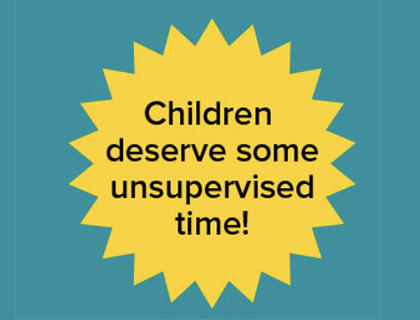Readers, once in a while — if you ignore the school safety drills involving real helicopters and the school boy suspensions involving imaginary guns — you can feel like things are going in exactly the right direction. This is one of those moments. Look at this article, “Call to Ditch Red Tape on Playtime Safety”:
…Paperwork designed to protect children at play can be discarded, according to “seminal” guidelines issued by the Health and Safety Executive.
In a plain-speaking statement,it dismisses the “misguided security blanket” of reams of paperwork that purport to prevent children from harm.
The statement went on to say that safety assessments should focus on “the real risk, not the trivial and fanciful.” Moreover, it begged bureaucrats to understand that looking at play solely through the lens of risk and liability has meant losing sight of the fact it is, overwhelmingly, health and good — not crazy and dangerous.
My friends at Common Good, the organization that tries to cut red tape and restore common sense, are, of course, thrilled that a department devoted to “health and safety” is “analyzing real health and safety instead of red herrings and black swans.” As a policy analyst there, Ben Miller, put it:
The biggest risk in most play areas isn’t bruises or scraped knees, it’s the ubiquitous fear of lawsuits that leads to red tape and replaces common sense with paranoia. Our mantra at Common Good is that people, not rules, make tings happen. We can’t regulate away every conceivable danger, but we can empower administrators to look out for children’s best interests — not lawyer’s.
The Health & Safety Executive outlined what it means to “strike the right balance” when it comes to legislating what’s allowed at playgrounds:
Weigh the risks and benefits when designing playgrounds and activities. (Not just the risks!)
Understand that the purpose of risk control is not to eliminate all risk, which is, of course impossible. Instead, the statement asks us all — the government and the people — to accept that the possibility “of even serious or life threatening injuries cannot be eliminated.”
Which is such an incredible thing to hear! So adult!
And it adds that our goal cannot be to continually reduce risk, nor demand “detailed assessments aimed at high-risk play activities” when examining low-risk activities.
That last tendency has led to things like outlawing tag, or requiring goggles when using thumbtacks at school, because when you look for risk with a magnifying glass, as has been the penchant of late. it will loom large even if it’s minute.
How exhilarating simply to start thinking of playgrounds as a happy place, instead of the mall of death. And how lovely to remember that play is something good, not just something that could go terribly, terribly wrong. Huzzah, Health & Safety Exec! And let’s hope your words soon echo over here!

Maybe playing is…good? Not just an injury or lawsuit waiting to happen?



19 Comments
I’m from the UK, so I’d like to add some context if I may. The Health & Safety Executive (HSE) get a lot of stick for stupid safety rules. Recently, they’ve started fighting back.
In the UK, it’s common to be told that something isn’t allowed because of “health & safety”. Usually, I suspect the real reason is “it’s easier to not allow it, and we’ll pass the blame onto the HSE”. The HSE are now encouraging people to ask exactly what regulations forbid the activity, because the regulations are, on the whole, simple common sense. If it sounds stupid, it’s probably not an actual regulation, and the HSE are being used as a scapegoat.
A few years back, a school required kids playing conkers to wear safety goggle, because of “health & safety”. The head teacher later admitted that there is no such health & safety regulation (which might explain why only one school in the country required goggles to play conkers).
Indeed, as Russell says, “health and safety” is often a convenient excuse for inaction. Just behind it comes “data protection”.
Which is not to diminish the importance of proper health and safety. Risks need proper assessment and management, not elimination, otherwise we would not cross the road or drive cars.
What always gets me about these “must keep the kids safe from all harm at play” rules is that we still allow our boys to play football.
In case any Americans don’t know what conkers is:
http://en.wikipedia.org/wiki/Conkers
I always learn new things here! 🙂
Good news. Let’s all play on!
The problem with common sense articles these days is that rational insight and facts will be ignored because the momentum of a society drunk on overreacting is like trying to stop a reckless drunk driver AFTER he’s already swerving all over the highway and hitting cars right and left.
It’s no longer about The Truth. Our Pavlov Society is “conditioned” to over-react.
I’m glad that The Common Good is looking out for, well, the common good, by fighting back against inane and excessive safety rules and policies for young people in institutions such as schools, summer camps, and organized activities, but I just have to wonder, how long is it going to take? If The Common Good is still a grassroots organization, then the Almighty Health and Safety Gods are still going to have much more clout, from both increased financial resources, and also because more people recognize “health and safety,” than The Common Good. So, again, it’s good that the tide is starting to turn, but I don’t think we should delude ourselves that this means that kids will suddenly be allowed to play tag, do cartwheels, and toboggan without helmets from now on. I know that the promise of change in the future is better than nothing, but kids have such a short time to be kids, that it might not do much good for the current generation of young people.
Conkers???? But what if a child is allergic to Chestnuts??????
Makes me proud to be British, even though I dont live there anymore. One factor that allows for common sense is that the culture of sueing isnt as prevalent over there..especially by ordinary folks.
Shortly after I read this, I cheered so loud that the neighbors came over and asked me the score of the rugby game because their TV isn’t working.
Hallelujah — though perhaps the cheering should wait until administrators, public officials, and others in charge actually change their behavior. What passes for sober reason and good judgment is often simply cowardice and resignation. People fear that they will be sued, so they cover their butts with regulations and protocol.
Thanks for highlighting the work of Common Good. I’m glad that someone is out there making the case against paranoia!
Let Her Eat Dirt
http://www.lethereatdirt.com
A dad’s take on raising tough, adventurous girls
@Donald – love it! Which game is it,BTW, and what is the score – I want to one-up my teenage son, who would be shocked that his mother knew something he didn’t….:-)
On the topic, great to hear commonsense is not altogether lost…
@Russell Phillips, Pentamom – after reading about Conkers, it sounds like a fun game. I think I even have a few chestnut trees in my area (seem to remember trying to pick chestnuts years and years ago)
@ShortWoman – good point, you could say that about both Football (what we crazy Americans call Soccer) and American Football.
Overall, good on the HSE for recognizing the need to not go overboard.
I regularly take my 3 and 5 year old children to a local council run pool here in Australia. The pool is free and completely unfenced, being in a local park. My son’s kindergarten teacher remarked how she was astounded that the pool was not fenced and that it the council were begging to be sued. Seriously, the pool is less than a foot deep and has been open since 1964. As far as I am aware there have never been any drownings. I fear that it is only a matter of time before the pool is fenced or filled in completely. How sad.
My 3 year old boy attends a pre-school program. When I picked him up last Friday I was told 5 times by 5 different teachers/caregivers he got a scratch on his cheek while playing on the playground, and a bloody nose in the classroom (an accident).My son told me he got the scratch from playing tag aroud a tree on the playground I had to sign a incident report about the injuries. I do understand they need to let the parents know what happened, but WOW.
On Monday when I droppped him off at his pre-school, the pre-school director approached me and said she had heard about the incident and wanted to check to see how my son was. She asked how he got the scratch on his cheek at their playground. I told her my son didn’t say (she’s the type that would have the tree cut down), and mentioned to her “it’s one of many scratches he’ll get as a kid”.
@Leanne–When I lived in Australia, there were a few different free pools by the beach–there was the lap pool, the family pool, the shallow kiddie pool (like the one you describe), and even a natural tidepool that was big enough to swim in. The first three pools were lifeguarded, but the tidepool was not. Anyway, they were free, and open to the public, but they were very much “old-school” pools–they were made of cement, and they were unheated, and filled with saltwater from the ocean instead of chlorinated water. The filtration system was pretty old-school too, so the pools (except the tidepool) were closed once per week for cleaning, usually on Mondays.
As for the fencing, they were only fenced on the side that faced the jogging/biking path, and on the “ocean” side, they were completely open. So, I suppose that someone could have easily snuck in and gone for a swim after hours, but the temptation to do that was fairly low, because there was the ocean right there. The pools were mostly there for swimming lengths for fitness (which I did fairly often), teaching kids to swim, introducting REALLY little kids to the water (kiddie pool), or for families to bring their kids. There were also a few local swim teams who practiced in the lap pool there. Anyway, I know that the ocean could have theoretically been used for all of these purposes, but it was really nice to have a place to swim when the ocean was too choppy, or too infested with blue bottle jellyfish, on any given day. I’d hate to think what would happen if the council had to start charging money at the pool to cover potential lawsuits–it’d probably really put a damper on the “community pool” atmosphere.
Thanks for posting the HSE High Level Statement on Risk and Play.
What also needs flagging up is the Chief Executive, Judith Hackitt’s excellent blog http://www.hse.gov.uk/news/judith-risk-assessment/index.htm